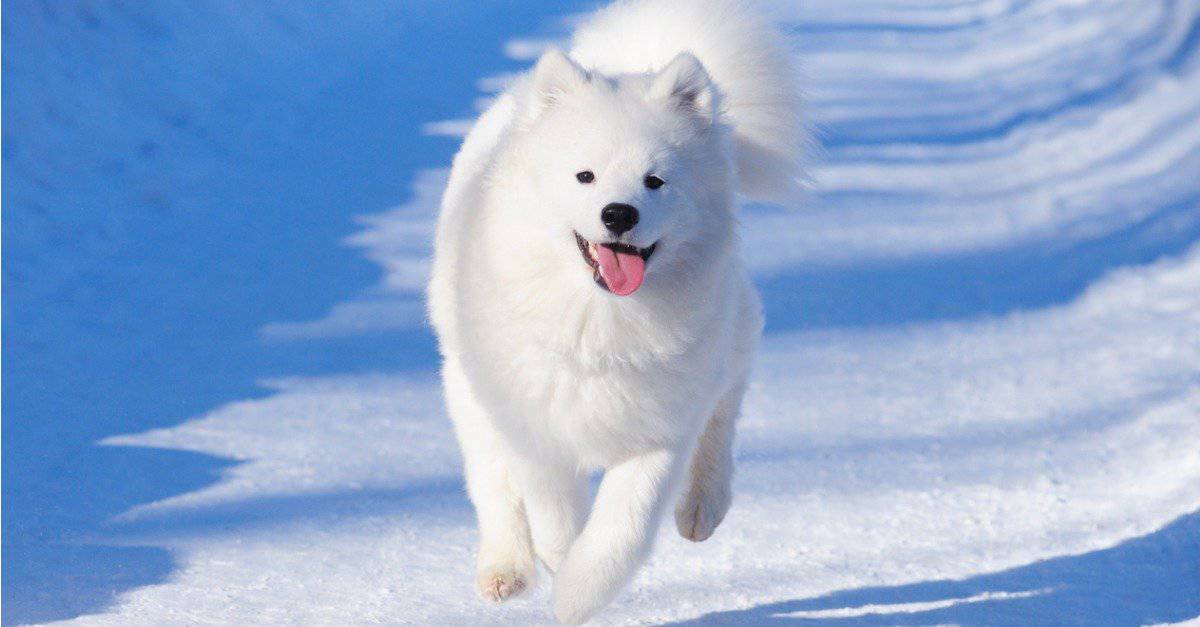With their signature smile and fluffy, white coat, Samoyeds could be mistaken for smiling clouds if they weren’t notorious barkers. Loyal, brave, intelligent, independent, and stubborn, this ancient dog breed belongs to a small group of dogs most closely related to wolves. Their double coat, slim muzzle, and wolfish ears served to help them survive in the harsh environment of their origin in northwestern Siberia where they herded reindeer, hunted, and pulled the Samoyedic people’s sleds. Today “Sammies,” as they’re also known, are found all over the world, from sunny Southern California to the Arctic wilderness of their Siberian homeland.
Samoyed Growth and Weight Chart by Age
The American Kennel Club (AKC) calls the Samoyed a “substantial but graceful dog standing anywhere from 19 to a bit over 23 inches at the shoulder” when fully grown. The average weight of an adult male Samoyed is between 45 and 65 pounds. Females tend to weigh in notably lighter at between 35 and 50 pounds. It’s also important to know the average size of your dog at different ages. While individual dogs will vary, the chart below provides a good estimation of what to expect as your Samoyed grows.
| Age | Male Weight | Female Weight |
|---|---|---|
| Birth | 8-13 oz | 8-13 oz |
| 1 Month | 3-8 lbs | 3-8 lbs |
| 6 Weeks | 6-10 lbs | 6-10 lbs |
| 2 Months | 10-15 lbs | 10-15 lbs |
| 3 Months | 15-20 lbs | 10-20 lbs |
| 4 Months | 20-30 lbs | 15-25 lbs |
| 5 Months | 25-35 lbs | 20-30 lbs |
| 6 Months | 30-40 lbs | 25-35 lbs |
| 7 Months | 35-45 lbs | 25-40 lbs |
| 8 Months | 35-50 lbs | 30-40 lbs |
| 9 Months | 40-55 lbs | 30-40 lbs |
| 10 Months | 40-60 lbs | 30-45 lbs |
| 11 Months | 40-60 lbs | 30-45 lbs |
| 12 Months | 45-65 lbs | 35-50 lbs |
| 2 Years | 45-65 lbs | 35-50 lbs |
When Will My Samoyed Stop Growing?
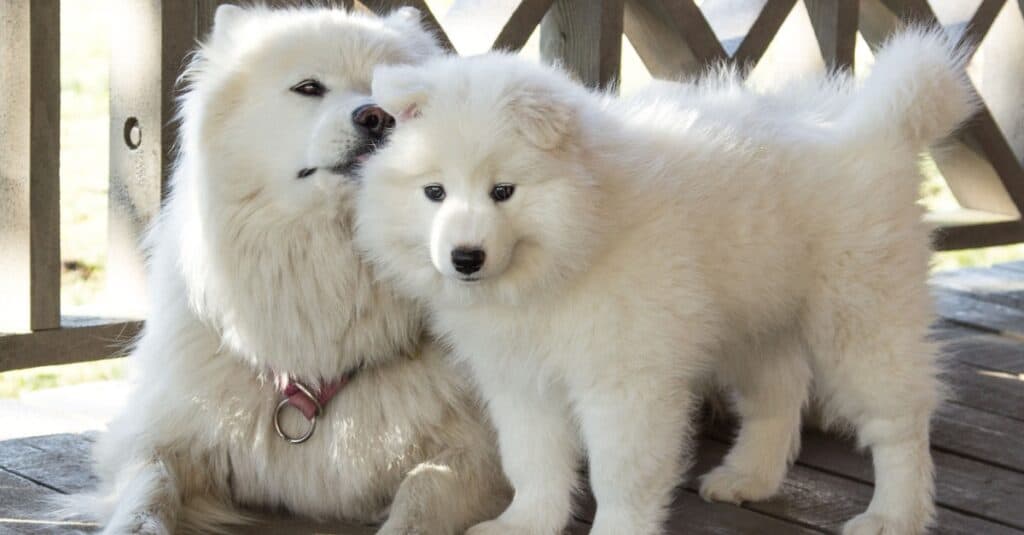
Bred to herd reindeer and pull sleds in the Arctic, Samoyeds have become popular pets all over the world.
©iStock.com/Irina Tetereva
Like all healthy puppies, Samoyeds’ growth trajectory in the first weeks after birth is impressive. By day seven after birth, a Samoyed puppy typically doubles his birth weight. Puppies will often triple their birth weight by the two-week mark. Thankfully, this spectacular growth speed slows down when your puppy is around seven months old.
While growth has slowed at seven months, your Samoyed still has a way to go before reaching maturity. When you hit the seven-month mark, you may be wondering how big your individual Samoyed will end up. There are a few ways you can estimate the size of your dog beyond the general growth chart.
- Paw Size: This is a great excuse to take a look at your Sammie’s cute paws. If his paws still seem big for his body at seven months old, he’s likely got a burst of growth still in him to fill out to fit his paw size.
- Gender: Female Samoyeds are markedly smaller than males. When considering which gender to choose, it’s important to take into consideration how big you want your Sammie to get.
- Parents: If you rescued your Samoyed, you likely won’t be able to use this method. Breeders, however, should be able to provide you with an estimate of your specific dog’s size based on her parents and previous litters.
There’s only one way to know for sure how big any dog will get, though. You just have to wait until he is done growing! Sammies typically reach maturity between one and a half to two years old. At this point, you won’t have to wonder anymore.
Feeding Your Samoyed
While their height is set by two years old, weight is another matter. What you feed and how much you feed your Samoyed will have a big impact on his health and weight. Pet owners have known for a long time that underfeeding or overfeeding their dogs can have adverse health consequences.
It’s important to know how much and how often to feed your Sammie. Feeding schedules and amounts vary based on age because growing puppies require more food relative to their size than mature dogs. The AKC reiterates an important adage in canine feeding: “Watch the dog, not the dish. Body condition, not the amount eaten or left in the bowl, should determine portion sizes.”
Samoyed Puppies
Samoyeds are playful puppies until anywhere from nine to 18 months old. At this stage, your fluffy ball of energy will be growing rapidly. Depending on your dog’s gender and heritage, you can expect to see your Sammie gain anywhere from 35-65 pounds.
Very young puppies, eight to 12 weeks old, should be fed four times a day. Puppies six months to a year old should get three meals a day. After a year, puppies should maintain a feeding schedule of two healthy meals per day.
Samoyed Adult Dogs
Samoyeds are high-energy animals. The more energy they burn throughout the day, the more often they need to be fed so they won’t be hungry. Nobody likes to feel hungry! The amount of food your furry friend requires to maintain a healthy weight depends on a few factors.
Bigger dogs and more active dogs need bigger meals. A typical Sammie should eat about three cups of food per day divided into two meals. They should get one meal in the morning and another about eight hours later. Quality dog food brands should have a guide with suggested feeding amounts on each bag of food.
Staying Healthy
All pets should always have free access to clean water. Puppies are “predisposed to rapid dehydration as a result of their higher water requirements,” DVM360 cautions. Water restriction, however, is dangerous to dogs of any age and can result in dehydration, urinary tract infections, bladder stones, and water obsessive behavior.
It’s important to maintain regular checkups with your veterinarian to ensure your best friend is eating the correct amount of food and staying healthy. Samoyed owners want their dogs to live long, happy, and healthy lives. Preventative care means visiting the vet on a schedule rather than when the animal shows signs of illness. Like many animals, dogs are adept at masking illness, so by the time a problem becomes obvious it can be advanced and more difficult to treat.
The chief veterinary officer for the AKC recommends that a vet evaluate every newly acquired puppy. Depending on if the puppy has already received any vaccinations, an eight- to 12-week-old puppy will need to go back to the vet every month to get the remaining vaccines until 16 to 20 weeks of age.
After your Samoyed gets all her core vaccines, annual wellness checkups provide the next line of preventative care. AKC vet, Dr. Klein, says taking your dog to the vet every year is “a touchstone” that is more important than many owners realize. These visits help dogs avoid obesity and dental disease, two of the top preventable health issues for dogs in the United States, as well as help owners monitor their Samoyed’s overall health.
How Big Will My Samoyed Be When Fully Grown?
Samoyeds are a medium-sized, sturdy breed. Their size at maturity will vary based on genetics, gender, and diet. Generally speaking, though, males will weigh between 50-65 pounds and hit about 22 inches at the withers. Females will weigh between 35-50 pounds and reach about 20 inches at the withers.
When Should My Samoyed Be Spayed or Neutered?
Part of being a responsible dog owner is ensuring the best quality of life for your Sammie. One way to do that is to spay or neuter, also known as “fixing,” your dog when they are ready. Spaying, for females, and neutering, for males, means removing the animal’s reproductive organs.
Along with helping fight pet overpopulation, there are serious health benefits to spaying or neutering your Samoyed. Fixing your dog promotes a longer, healthier life for both males and females.
According to the American Animal Hospital Association’s Canine Life Stages Guidelines, the decision of when to spay or neuter your pet should always be something discussed with your veterinarian. While it’s generally accepted practice to spay or neuter a puppy around six months of age to avoid certain cancers, the recommended window is broad (five to 15 months old). Your vet will be able to consider your Samoyed’s individual health concerns when helping you decide what age is best for your dog.
Spaying Your Female Samoyed
Spaying helps prevent uterine infections and breast cancer, which is fatal in about 50 percent of dogs. Making sure to spay before her first heat at around six months old offers the best protection from these diseases. Unspayed female dogs normally experience heat cycles every six months, lasting between 2-4 weeks.
Neutering Your Male Samoyed
For males, neutering prevents testicular cancer if done before six months of age. Along with preventing cancer, you can help avoid problems with your dog marking with strong-smelling urine. Early neutering can also help prevent many aggression problems.
When Should My Samoyed Be House Broken?

Patience is key to successfully potty training your Samoyed puppy.
©Sergii Chernov/Shutterstock.com
Samoyeds are unique dogs, well-loved for their fluffy, white fur, energetic nature, and heart-melting smile. While unique, they are still dogs, and like all dogs, they need to be potty trained. Thankfully, potty training a Samoyed is like working with any other dog, so once you work it out with your Sammie, you’ll be an expert for good!
According to WebMD, experts recommend that you start house training Samoyeds when they are between 12-16 weeks old. Training a puppy not to go to the bathroom in the house involves a few simple, but vital steps. You will need to take him outside often, give him treats and praise immediately, have a routine for everything from mealtimes to going outside, and most importantly, you will need a lot of patience. Your goal is to instill good habits while solidifying a loving bond with your new fluffy family member. Staying consistent is key to setting your Samoyed up for success!
Steps To Potty Train Your Samoyed
Take Your Puppy Outside on a Consistent Schedule
The younger the puppy, the more you will need to bring him outside. Take your Samoyed puppy outside first thing in the morning and then again every 30 minutes to an hour when you are first starting. Make sure they get outside after meals or after waking up from a nap.
Part of being consistent is also taking your puppy to the same place to relieve themselves. Their scent will prompt them to relieve themselves and create an association. Until they are completely housebroken, it’s a good idea to stay with them while they are outside as they are less likely to rush back into the house looking for you.
Reward Your Sammie Immediately
All puppies, even your exceptional Samoyed, have short attention spans. Rewards must be given as soon as they display good behavior. The longer you wait, the less likely they will connect the good behavior with the reward. Treats, praise, pets, and a walk together are great ways to show your Samoyed you are proud of her.
Stock Up on Patience
Housebreaking a puppy can be seriously frustrating. It takes time for puppies to remember that the bathroom is outside. For most Samoyed puppies, they need anywhere from five months to a year to fully understand their side of the bargain.
Punishing your puppy for having an accident will only teach him to fear you. Positive reinforcement is always the best approach. If you do catch your Sammie in the act, clap loudly so they are aware they are doing something you don’t like.
Call them or gently lead them outside and praise them when they go to their spot. Puppies will never connect your anger with their accident if you find their mistake after they did it. It’s best to just clean up accidents with an enzymatic cleaner and move on. Inevitably, there will be some mistakes you will need to clean. Luckily, your Samoyed’s playful nature and signature grin will make it all worthwhile.
When Should My Samoyed Stop Eating Puppy Food?
Making the Switch
They grow up so fast! One day you are chasing a speedy cotton ball around the house and the next you are picking out adult dog food at the pet store. Growing puppies require a more nutrient-rich diet than mature dogs. You want the best for your growing cotton ball, so it’s good to know the right time to transition to adult dog food.
The AKC recommends that sometime between six to 12 months, or after they are spayed or neutered, dogs should switch to adult maintenance food. Be sure to err on the side of caution. It is always better to be on puppy food a bit too long than not long enough. The AKC says that bigger breeds can switch later than little dogs. Since your Samoyed is somewhere in the middle, you can wait until as late as his first birthday to make the switch.
Young Samoyeds are known to not be as food-driven as many breeds their size. You may often need to encourage your dog with meat juices to entice him to eat. Adding chicken broth to a quality dog food will likely do the trick.
Top Choices for Samoyed Dog Food
Caninebible.com offers some great recommendations for the best dog food for Samoyeds. Their choice for Best Overall is Ollie, which is made with fresh, human-grade ingredients. The website’s choice for Best Dry Food for Samoyeds is Spot & Tango, described as “a new kind of dry dog food with the flavor and benefits of fresh food with the convenience of kibble.” The vote for the Best Samoyed Puppy Food went to Open Farm.
There are many high-quality options for food appropriate for Samoyeds of all ages. Just make sure that whatever food you choose is approved by the Association of American Feed Control Officials, has a high-quality protein as the first ingredient, is made in the United States, and is something your Samoyed enjoys.
When Will My Samoyed Start Losing Teeth?
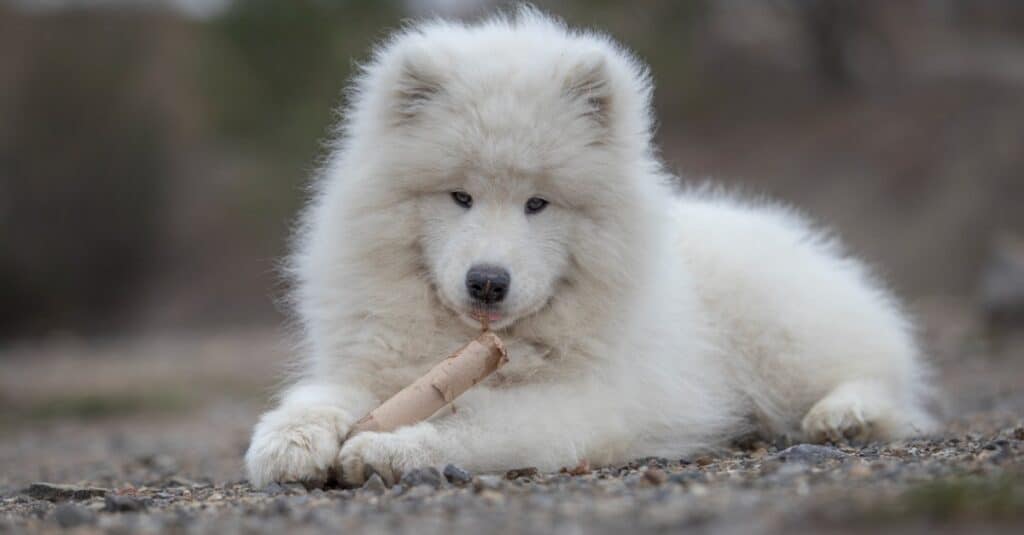
Samoyed puppies need toys to chew on while they are teething.
©iStock.com/Roman Bjuty
Just like human children, puppies have baby teeth that need to fall out. By five to six weeks, your Samoyed’s 28 baby teeth will have grown in. At about 12-16 weeks, around the time most breeders send off their puppies, Samoyeds start losing their baby teeth.
You may find little rice-sized teeth around your home as your Sammie starts to shed his teeth. Anyone who has ever cared for a teething human baby knows this process can be painful. Babies and puppies find relief in chewing on things. You should offer your Samoyed puppy safe chew toys so he doesn’t resort to using your shoe instead. At this point in his development, a Kong chew toy is a great option.
By the time your Samoyed is around six months old, all of her adult teeth should be grown in. Adult dogs have about 42 teeth, 10 more than humans! At this point, if any baby teeth remain, be sure to let your vet know as they may need to be removed.
When Should I Start Training My Samoyed?
Samoyeds are exceptionally intelligent dogs. They are a working breed that craves action, herding, and attention. Their intellect, coupled with their working dog heritage, makes them prone to boredom if they are not provided with sufficient stimulation. Samoyeds are happiest with active owners, and most well behaved when they have opportunities for little adventures.
While making sure your Sammie gets enough exercise and stimulation outside of the house is key to a well-behaved best friend, training is also vital to you and your dog’s happiness. Thanks to their herding instincts, they are ambitious to learn. Training should begin early, by around seven or eight weeks, once they are mature enough to understand cues, commands, and rewards. When you aim to start training at a young age, you can help shape good habits rather than creating more work by having to break bad habits.
Samoyed are known for being stubborn and independent dogs. These characteristics served them well when the breed worked independently in the wilds of Siberia to protect and herd reindeer.
The Samoyed Club of America shares its wisdom on handling your companion Samoyed. “The answer is in the handling, not by forceful demands, but by an understanding of love and respect between them. The Samoyed has a mind of his own; respect it and he will comply with love and patience.”
What Cues Should I Teach My Samoyed First?
Positive Reinforcement
Training your Samoyed is a wonderful opportunity to develop your relationship with your best friend. Sammies are eager to please a fair and consistent owner. Positive reinforcement rather than punishment goes a long way to prove to your puppy that you can be trusted.
Reinforcement can be anything your dog enjoys. Treats, praise, or a favorite toy can all be used as rewards. Avoid punishing mistakes with leash corrections or yelling. These confuse your puppy and make an intelligent Samoyed suspicious of you.
Many experts recommend that Samoyed puppies attend a puppy training/socialization class when first starting out. Socializing with other dogs and people is an important aspect of training. There are many commands, however, that you can start teaching your Samoyed on your own. They all require patience and repetition.
Five Basic Cues
The AKC recommends starting with five basic cues.
- Recall — start by training a recall (to come when called) in a distraction-free area or indoors.
- Loose-leash walking — teach your Samoyed puppy to walk next to you on a leash without pulling.
- Sit — the two options for teaching your dog to sit are capturing and luring. Capturing means holding a treat in front of them, waiting for them to sit, and then rewarding them when they sit. Luring means putting a treat in front of your puppy’s nose and lifting it slowly higher while they watch. They will likely sit as they lift their head. Allow them to eat the treat when their bottom touches the ground.
- Down — teaching a dog to lie down can be done similarly to teaching them to sit. “Capture” your dog lying down on his own and reward him while saying “down.” Alternatively, you can lure them by bringing a treat lower onto the floor.
- Stay — when teaching a dog to stay, the AKC instructs trainers to first teach their dog their “release” word. This is the word they use to tell dogs they no longer need to stay.
When Will My Samoyed Calm Down?
Anyone who’s ever been around a Samoyed knows they are high-energy, working dogs. They need daily exercise and stimulation to stay out of trouble. Dog owners are all familiar with the adage, “A tired dog is a good dog.” Samoyeds are best suited to owners who are active and like to participate in outdoor activities. They need a minimum of two hours of exercise every day.
While they will continue to be very active, high-energy dogs most of their lives, you can expect your Samoyed puppy to adjust to his daily routines better around 24-36 months old. By this time, he should be less excitable, although there are many variables like the amount of exercise and training you provide.
The AKC offers a great resource for owners looking for help with training or behavioral issues. Their AKC GoodDog Helpline is a live telephone service that offers individualized advice for all dog owners needing support with unwanted behaviors. They also provide video training consultations with AKC trainers.
Common Health Issues Your Samoyed Might Experience
Samoyeds are generally healthy dogs. You can expect your Sammie to live up to 14 years with good care, nutrition, and exercise. As with most breeds, though, Samoyeds can be genetically predisposed to several medical issues.
PetMD lists retinal diseases, Uveodermatologic Syndrome, a few heart problems, hip dysplasia, and Samoyed Hereditary Glomerulopathy as problems of concern for Samoyeds. The heart issues are atrial septal defect, aortic stenosis, and pulmonic stenosis. Their sensitivity to warmer temperatures can lead to other health problems. Samoyeds are also prone to teeth issues due to a disorder known as familial enamel hypoplasia, which causes weak enamel on Samoyeds’ teeth.
Samoyed Puppies
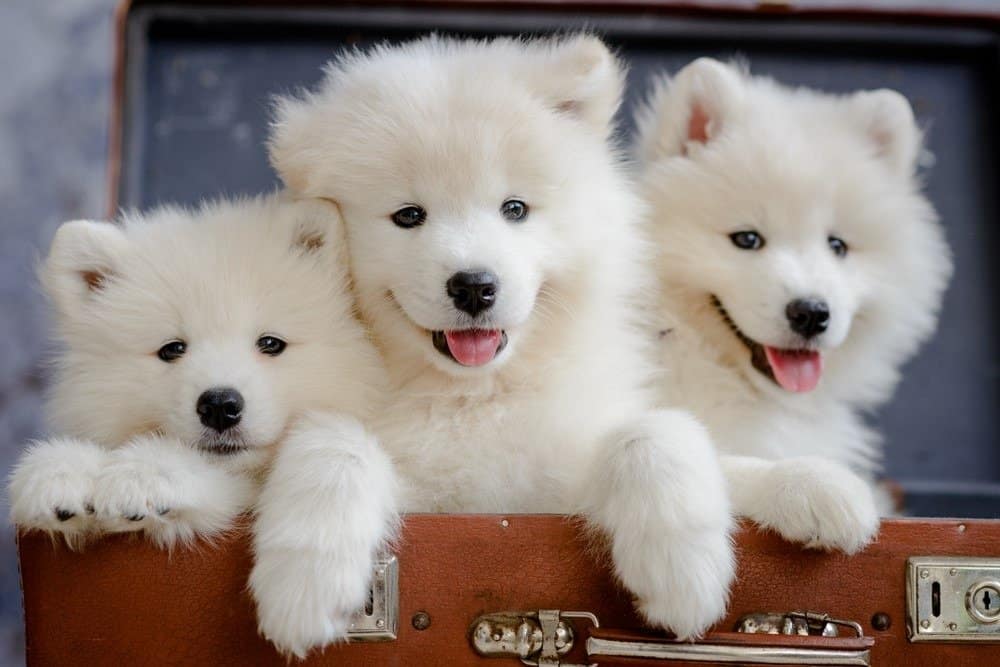
Also known as “Sammies,” Samoyeds have a signature perpetual smile on their face.
©Nadezhda V. Kulagina/Shutterstock.com
Samoyeds at Six Months
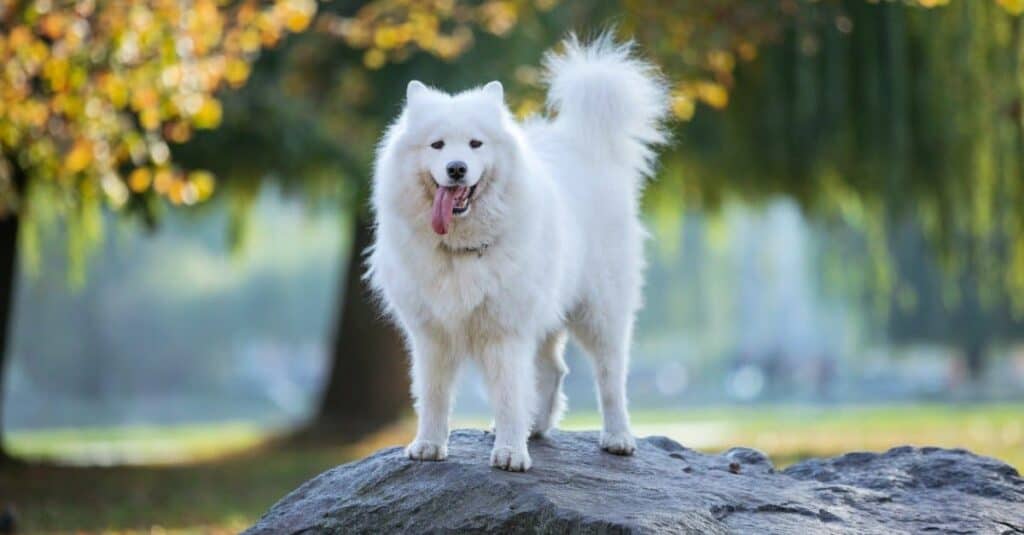
Samoyeds are high-energy companions and need at least two hours of exercise a day.
©iStock.com/photobac
Fully-grown Samoyeds

Samoyeds need a lot of grooming from their owners to keep their coats unmatted and clean.
©Ilya Barmin/Shutterstock.com
Ready to discover the top 10 cutest dog breeds in the entire world?
How about the fastest dogs, the largest dogs and those that are -- quite frankly -- just the kindest dogs on the planet? Each day, AZ Animals sends out lists just like this to our thousands of email subscribers. And the best part? It's FREE. Join today by entering your email below.
Thank you for reading! Have some feedback for us? Contact the AZ Animals editorial team.

